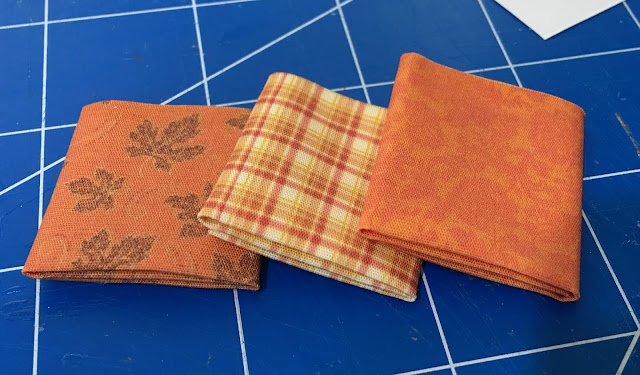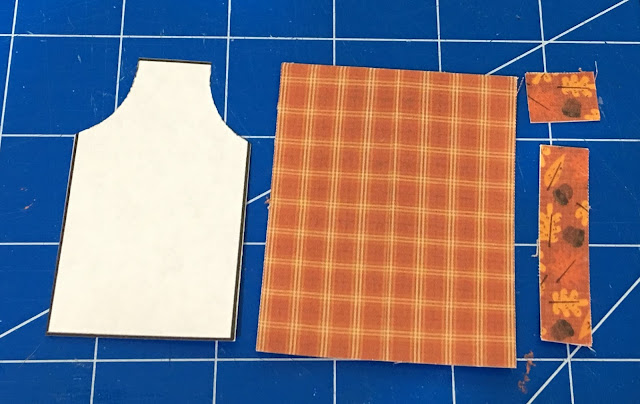I have posted before about the Inkjet Fabric Sheets on Amazon that I use, but here it is again for the new folks. It comes in US standard printer size which is 8.5" x 11", but I believe you can find it in A4, as well. Maybe in a different brand, too. I just tend to stick with the brands that I have success with. The sheets feed into the printer in the exact same way that office paper does, though I just load in one sheet at a time so that a mis-feed and resulting waste of expensive fabric doesn't occur. It is very thin, but looks really good in a variety of household objects, even rugs. I find that increasing the color intensity of the ink by 10-15% (in your print settings) makes for a richer end result. If you want a faded, shabby look, decrease the ink intensity a little.
I look for fabrics online from many different sites. I also scan in scrapbook paper that I like. If there is only a small section of fabric, I fuse together several images to achieve the size of piece and pattern I like. Below is a sheet I printed and it includes tablecloths, fold-over potholders, tea towels, washcloths, and pieces to make an apron (tutorial later in the post).
The fabric comes with a peel away backing but it has no residue. Do not peel the backing paper away until you are ready to assemble the fabric into your desired object. It frays really easily and needs to be glue hemmed. I generally use an Xacto knife and steel ruler to cut the straight edges from the sheet because my scissor skills leave a lot to be desired.
You don't really need to make a full scale version of things you'll display folded. These tablecloths are only 2.7" W x 3.5" L, but when folded and displayed, pass for the real deal.
To make a tea towel for a drawer or a basket, you'll just fold into thirds and glue the left and right thirds together on the back. Then fold in half. Regular Tacky glue, used sparingly and spread evenly, works great.
If you want to display a tea towel on a towel bar, or when the ends will show, you can create fringed ends. Leave 1/8" at the end of the fabric free of glue. To prevent the fray from going beyond where you want it to, run a thin bead of glue across both ends of the towel. Let dry completely.
Then, just carefully remove the horizontal threads from the 1/8" end of the towel.
Ta-da! Fringe! This method works great for rugs, too. Then just fold the towel as above.
Now for a super simple but really cute apron. I first discovered this easy no sew method when making a potting shed for my aunt for her 70th birthday. That was way back in 2015 and was the first thing I ever blogged about. For that apron, I used a piece of the quilt my grandma had made me growing up. I knew using that material would mean a lot to my aunt, and it did!
You'll need:
Apron Pattern (provided)
2-5/8" x 1-9/16" Fabric
1-9/16 x 1/2" Coordinating Fabric For Bottom Strip
1/2" x 5/8" Coordinating Fabric For Pocket
16" of 1/8" width Coordinating Silk Ribbon
Two 1/16" Flat Back Pearls, Buttons or Metal Studs
Tacky Glue
Scissors
Toothpicks
Apron Pattern.
Cut your fabric pieces and your pattern.
Fold pattern in half and place centered on your fabric. This will let you see how wide the seams will be on each long side.
Create a seam on each of the long sides of the fabric with a thin layer of Tacky Glue. Fold and press.
Using the pattern, carefully cut the arm curves. Create a 1/16" seam along the raw edges with Tacky Glue. Let dry.
Apply a thin layer of Tacky Glue to the bottom piece of the coordinating fabric (1-9/16" x 1/2" piece).
Affix to the bottom edge of the apron. If it is too long you can trim or glue and fold back.
Apply a thin layer of glue to the pocket piece of fabric (1/2" x 5/8"piece). Attach centered on the apron, 3/4" below the neckline.
Cut two pieces of silk ribbon 5/8" long. Glue to either side of pocket.
Measure and cut a piece of silk ribbon for the top of the pocket which is long enough to cover both side ribbon pieces. Glue.
Apply a thin line of glue across the middle of the apron, using the pocket's bottom as a guide. Cut a piece of silk ribbon 5" long. Fold in half to find the center. Place centered on the pocket across glue. Cut the ends to points and then seal the ribbon ends with a tiny amount of glue.
Cut two pieces of ribbon slightly longer than the bottom fabric piece. Using a thin layer of Tacky Glue, attach one strip at the top of the bottom fabric and one at the bottom.
Turn the apron over. Add a thin layer of Tacky Glue to each of the four exposed bottom ribbon strips, then press into the back of the apron. This is so that if seen from the side, it gives the illusion of printed fabric on the back.
Measure and cut a piece of ribbon for the neckline of the apron. Glue.
Cut a 3-3/4" piece of ribbon for the apron's neck strap. Apply a small dot of glue where the neckline ribbon meets the left edge of the apron at the arm curve. Press the end of the strap ribbon into it and let dry completely.
Attach the strap's opposite end to the right neckline/arm curve, twisting the ribbon so that the same side of the ribbon is affixed.
Apply a small dot of glue to the center of both places where the neck strap meets the neckline ribbon.
Set a flat back stud/button/pearl on top of the glue. TIP: To pick up the stud/button/pearl easily, wet the flat end of a toothpick with your tongue. Touch it to the center of the right side of the stud. It will stick long enough to place it where you want it.
You can fold and bend the apron into a natural shape. You can also glue down the back ties, and even tie the neck strap into a cute bow.
Or just leave it long like a chef. I've made dozens of different configurations of these over the years. Just have fun and use your imagination!
I used tulle for the chicken wire doors. It was yellow, but a quick paint wash made them look rusty.
I played around with the decor items to find the best arrangement. Some pieces needed a little paint and glaze. The empty bottles and pitchers will need fall flowers, but that will come later. I made the wreaths last summer when I was working on the Storybook Cottage's garden. I knew they's come in handy!
And now I'll leave you with shots of the finished back and right walls of the shop. The hutch ended up being the perfect piece for this spot and really allowed me to display a colorful and varied amount of all the good home goods!
In the next few days, I hope to start on the window displays, counter displays and floor displays. Then the flowers the week after. I feel hopeful about having the project pretty close to being finished for the first day of fall, but you know who laughs when we have plans. Either way, I intend to enjoy the journey!
Wishing you all pleasant journeys!
xo xo,
Jodi










































































































